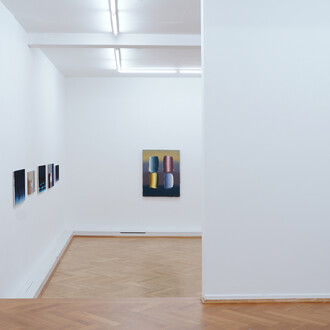The international group exhibition chasing another tomorrow is devoted to questions about different visions of the future and the respective effects of technology on humankind and the present day.
Back in the 1970s, there was still a positive and shiny image of the future. In the present, a notable loss of confidence in the positive effects of technical progress has begun to inspire alternative, artistic future scenarios. The exhibition reveals this through an extended recourse to nature, the abstraction of pop-cultural references and the thematization of communication, architecture and power structures, resulting in a complex interplay of technical components, geometric shapes and natural elements. The gallery is transformed into a kind of mystical landscape in which natural and technoid elements enter into a dialogue and manifest an alternative future vision of our future.
As one of the pioneers of post-minimal art, Keith Sonnier (1941-2020) revolutionized the concept of sculpture in the 1970s with his use of novel materials such as neon, latex, foam or new media, such as the TV. Based on a selection of early works, the exhibition shows how the artist increasingly experimented with light and neon as material in his practice.
Central to the exhibition is the installation Standing Stones (Solar Symphony 8) by Haroon Mirza (*1977 in London, UK), which combines technology and references from ancient cultures. A solar panel is diagonally attached to a large black stone sculpture, across from which a smaller stone stands in opposition. While tracking the sun‘s movement across the sky, the solar panel generates electricity, powering a series of LED lights and a speaker. Mirza’s particular fascination for electricity as a material is based in his interest in music and sound, which are repeatedly utilized as determinative media in his artistic work. In addition to high-tech elements, the work also pertains to ancient rituals, referring to monoliths and stone circles like Stonehenge, which probably serves as the most famous example. Most recently, the sculptures were exhibited in the park of the Museum Tinguely in Basel.
The works of the recurring Venice Biennale participant Neïl Beloufa (*1985 in Paris, FR) combine a wide variety of materials and techniques, which often include visible technological components and digital devices such as toggle switches, sockets and monitors. In his wall objects, the momentous effects of human actions on Nature are thematized, merging fiction with reality, everyday materials with landscape references or organic forms in an almost indistinguishable manner.
Rather than creating traditional illusory pictorial spaces, Natacha Donzé (*1991 in Boudevilliers, CH) drafts dimensionless spaces in her work, poised between our own reality and the distant images of the future or the past, hinting at a vague narrative through abstract forms of cultural tokens. In her works, Donzé deconstructs the power structures of institutional, political and commercial systems of the present by taking up fragments of these orders and embedding them in a non-hierarchical within her own visual worlds.
Chasing another tomorrow will directly be followed by the exhibition’s second chapter inventing the past, which shifts the time horizon within the same thematic examination and thus propagates a new consideration of the artistic works.















